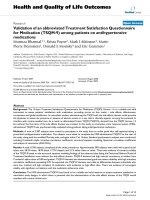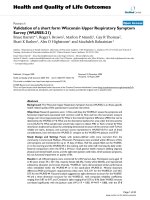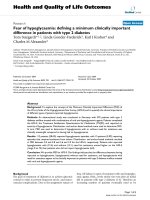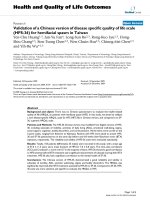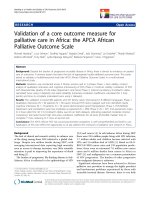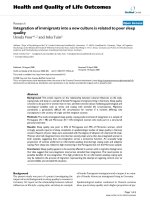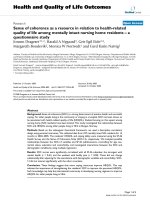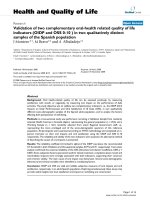báo cáo hóa học:" Validation of the Burden Index of Caregivers (BIC), a multidimensional short care burden scale from Japan" pdf
Bạn đang xem bản rút gọn của tài liệu. Xem và tải ngay bản đầy đủ của tài liệu tại đây (393.01 KB, 9 trang )
BioMed Central
Page 1 of 9
(page number not for citation purposes)
Health and Quality of Life Outcomes
Open Access
Research
Validation of the Burden Index of Caregivers (BIC), a
multidimensional short care burden scale from Japan
Mitsunori Miyashita*
1
, Aki Yamaguchi
2
, Mami Kayama
3
, Yugo Narita
4
,
Norikazu Kawada
5
, Miki Akiyama
2
, Akiko Hagiwara
6
, Yoshimi Suzukamo
7,9
and Shunichi Fukuhara
8,9
Address:
1
Department of Adult Nursing/Palliative Care Nursing, School of Health Sciences and Nursing, Graduate School of Medicine, The
University of Tokyo, Tokyo, Japan,
2
Department of Psychiatric Nursing, School of Health Sciences and Nursing, Graduate School of Medicine, The
University of Tokyo, Tokyo, Japan,
3
Department Psychiatric Nursing, St. Luke's College of Nursing, Tokyo, Japan,
4
Department of Neurology,
Graduate School of Medicine, Mie University, Mie, Japan,
5
Department of Neurology, Matsusaka chuo General Hospital, Mie, Japan,
6
Fukuyama
Transporting Shibuya Longevity Health Foundation, Hiroshima, Japan,
7
Departmet of Physical Medicine and Rehabilitation, Tohoku University
Graduate School of Medicine, Sendai, Japan,
8
Department of Epidemiology and Healthcare Research, School of Public Health, Kyoto University,
Kyoto, Japan and
9
iHope International (Institute for Health Outcomes & Process Evaluation Research), Tokyo, Japan
Email: Mitsunori Miyashita* - ; Aki Yamaguchi - ; Mami Kayama - ;
Yugo Narita - ; Norikazu Kawada - ; Miki Akiyama - ;
Akiko Hagiwara - ; Yoshimi Suzukamo - ;
Shunichi Fukuhara -
* Corresponding author
Abstract
Background: We constructed a concise multidimensional care burden scale that reflects circumstances unique to Japan,
with a focus on intractable neurological diseases. We surveyed 646 family caregivers of patients with intractable
neurological diseases or stroke using 28 preliminary care burden scale items obtained from qualitative research. The
results were used to finalize the feeling of care burden scale (BIC: burden index of caregivers), and verify its reliability
and validity.
Methods: The survey was conducted among caregivers providing home health care to patients with intractable
neurological diseases (PD [Parkinson's disease], SCD [spinocerebellar degeneration], MSA [multiple system atrophy], and
ALS [amyotrophic lateral sclerosis]) or CVA (cerebrovascular accident) using a mailed, self-administered questionnaire
between November, 2003 and May, 2004.
Results: Response rates for neurological and CVA caregivers were 50% and 67%, respectively, or 646 in total (PD, 279;
SCD, 78; MSA, 39; ALS, 30; and CVA, 220). Item and exploratory factor analyses led to a reduction to 11 items,
comprising 10 items from the 5 domains of time-dependent burden, emotional burden, existential burden, physical
burden, and service-related burden; and 1 item on total burden. Examination of validity showed a moderate correlation
between each domain of the BIC and the SF-8 (Health related quality of life scale, Short Form-8), while the correlation
coefficient of the overall BIC and CES-D was 0.62. Correlation between the BIC and ZBI, a preexisting care burden scale,
was high (r = 0.84), while that with the time spent on providing care was 0.47. The ICC (Intraclass correlation coefficient)
by test-retest reliability was 0.83, and 0.68 to 0.80 by individual domain.
Conclusion: These results show that the BIC, a new care burden scale comprising 11 items, is highly reliable and valid.
Published: 18 August 2006
Health and Quality of Life Outcomes 2006, 4:52 doi:10.1186/1477-7525-4-52
Received: 03 July 2006
Accepted: 18 August 2006
This article is available from: />© 2006 Miyashita et al; licensee BioMed Central Ltd.
This is an Open Access article distributed under the terms of the Creative Commons Attribution License ( />),
which permits unrestricted use, distribution, and reproduction in any medium, provided the original work is properly cited.
Health and Quality of Life Outcomes 2006, 4:52 />Page 2 of 9
(page number not for citation purposes)
Background
The concept of the burden of care was defined in 1980 by
SH Zarit, an American gerontologist, as the discomfort
experienced by the principal caregiver of an older family
member, including the caregiver's health, psychological
well-being, finances, and social life [1]. Since then, a
number of burden scales to assess the care burden of fam-
ily caregivers of impaired or elderly patients have been
developed in various countries, including Japan, such as
the Zarit Burden Interview (ZBI), Caregiver Strain Index
(CSI), Care Burden Inventory (CBI), Caregiver Reaction
Assessment (CRA), Care Burden Scale (CBS), and Naka-
tani's Burden Scale [1-9]. In particular, the ZBI has been
validated in Japan and used in a large number of studies
[2,10-12]. The ZBI does not, however, have a clear
domain structure, nor does it necessarily correspond to
various aspects of the care burden [8,13]. In contrast, the
CBI and CRA have been developed with a clear domain
structure [5-7]. Very few multidimensional scales have
been developed in Japan, apart from the CBS developed
by Niina, which comprises 28 items covering 9 domains
[8]. However, this relatively high number of items is bur-
densome to respondents.
Japanese health policy now provides various preferential
treatment conditions to patients with any of a number of
neuromuscular diseases, including amyotrophic lateral
sclerosis (ALS), multiple system atrophy (MSA), spinocer-
ebellar degeneration (SCD), and Parkinson's disease
(PD), under the framework of "incurable diseases".
Despite increased subsidization of costs, however, the
heavy burden of home care for these patients has
remained [14,15].
Our previous study, Outcomes Research of Specific Dis-
eases (PI: S. Fukuhara), was conducted under the auspices
of the Japanese Ministry of Health, Labor and Welfare to
investigate the feelings of burden among caregivers of
patients, mostly with ALS, and identify those burdens
related not only to time constraints and depression, as
conventionally noted, but also to the difficulty in finding
meaning in prolonging a patient's life and to difficulties in
receiving public nursing services [16,17].
Here, we used the results of this qualitative research to
construct a concise multidimensional care burden scale
that reflects circumstances unique to Japan for caregivers
of patients with mainly intractable neurological condi-
tions. Further, we also verified the reliability and validity
of the scale.
Methods
Participants and procedure
Participants were caregivers providing home healthcare to
patients with intractable neurological conditions and to
stroke patients between November, 2003 and May, 2004.
A self-rating questionnaire was mailed to all caregivers of
patients registered as having the intractable neurological
conditions PD, SCD, MSA, and ALS in Mie Prefecture,
Japan.
The participants were requested to answer the question-
naire and return the answer sheets. As the qualitative
interview study progressed, characteristics of the care bur-
den for neuromuscular disease were found to be similar to
those for other diseases, including cerebrovascular acci-
dent (CVA), which is the leading cause of bedridden eld-
erly in Japan. Therefore, in consideration of the possible
application of the instrument to diseases other than
intractable neurological conditions, we also included car-
egivers of patients with CVA. For this CVA component, the
questionnaire was sent to outpatient, day care, rehabilita-
tion, and visiting nurse station departments of the Brain
Attack Center Oota Memorial Hospital, a neurological
hospital in Hiroshima Prefecture, Japan, for distribution
to caregivers who provide nursing care at home to patients
following cerebral infarction, cerebral hemorrhage, and
subarachnoid hemorrhage. These caregivers were simi-
larly asked to answer the questionnaire and return the
answer sheets by mail. To examine reliability, two-week
test-retesting of the questionnaire was done in consenting
caregivers of stroke patients.
Measurements
Before the survey, a qualitative study was conducted to
collect data and interview primary caregivers of patients
with PD, ALS, and CVA. A total of 22 caregivers were inter-
viewed and analyzed. This study used the theoretical sam-
pling method. Caregivers were interviewed for 1.5 h at
home under written consent with questions such as "what
is the hardest thing about caring for the patient?" The data
were analyzed using the grounded theory approach and
constant comparative method by means of open, axial
and selective coding [16,17]. Data were continually ana-
lyzed as they were collected, with comparison between
newly gathered data and previous data to examine simi-
larities and differences. Analysis was supervised by a qual-
itative researcher and results were discussed among
neurologists and nurses experienced with neurology
patients to examine validity.
Characteristic results revealed care burden items such as
"difficulty with finding meaning in prolonging life"
(anguish of caregivers in continuing care) and difficulty
with finding "a sense of satisfaction" due to a lack of
appreciation from other family members, relatives, and
others. These items had not been included in the conven-
tional scale. In addition, the qualitative study also
extracted an item that reflected the current situation of
troubled caregivers whose patients resented receiving
Health and Quality of Life Outcomes 2006, 4:52 />Page 3 of 9
(page number not for citation purposes)
public nursing care services, despite having agreed to do
so before the services were made available. We then com-
bined our qualitative research results and literature review
[1-9] to prepare a preliminary group of 28 care burden
scale items. A number of items, including overall burden,
were adopted from pre-existing care burden scale items
and their wording was revised. The 28 care burden items
comprised 27 items of specific burdens (e.g. "I do not
have enough time for myself," "I am completely distressed
by caregiving", et al), assessed using a 5-point Likert scale
from 0: never, 1: almost never, 2: sometimes, 3: often, to
4:always; and 1 item of overall burden i.e. "how much
burden do you think providing care is to you?" To exam-
ine content validity, three caregivers, two neurologists,
and two visiting home nurses checked the questionnaire.
The following instruments were also measured to exam-
ine construct and concurrent validity:
1. The Health-related QOL Scale SF-8 [18] short form of
the health-related QOL scale SF-36. Its 8 items are
assessed by a 5- or 6-point Likert scale, and include phys-
ical functioning (PF) (5-point Likert scale), role function-
ing physical (RP) (5), bodily pain (BP) (5), general health
perception (GH) (6), vitality (VT) (5), social functioning
(SF) (5), role functional emotional (RE) (5), and mental
health (MH) (5). In this study, we used each item sepa-
rately. Higher values represent better QOL.
2. The Center for Epidemiologic Studies Depression scale
(CES-D) [19,20], developed by the National Institute of
Mental Health, USA, is a self-report scale to identify
depression which has been translated into Japanese by
Shima. Its 20 symptomatic items are self-assessed to iden-
tify the number of days per week a subject is affected by
depression, as "none", "1 to 2 days", "3 to 4 days", "5 or
more days," providing for a total score of 0 to 60, with a
higher score representing a stronger tendency toward
depressive feelings.
3. The Zarit Burden Interview [1,2], a care burden scale
developed by Zarit and translated into Japanese by Arai,
comprises 22 items assessed by a 5-point Likert scale to
provide a total score of 0 to 88, with a higher score repre-
senting a greater care burden.
Regarding demographic factors, we collected information
on caregiver's age, gender, relationship to patient, work-
ing status, income, period of nursing, daily hours spent on
nursing, hours required for close supervision of the
patient, patient's age, level of ADL (as determined by the
Ministry of Health, Labor and Welfare), and Barthel Index
(for CVA only) [21].
Statistical analysis
We first prepared a multidimensional scale by selecting
items from the 28 preliminary items. In the item-selection
process, we performed item analysis to confirm that
selected answers were not heavily weighted on either end
of the 5-point scale (i.e. 80% or more responders selected
points 0 and 1 or 4 and 5), and examined reproducibility
with a weighted kappa coefficient to exclude items with κ
value < 0.5. On the basis of these results, we confirmed
multidimensionality by an explanatory factor analysis
(principle method with a promax rotation), applied the
item response theory (marginal maximum likelihood
method, graded response model) to each factor, and
determined the difficulty level and discrimination power
of each item. We then adopted those items which
included a difficulty level of 0 and a discrimination power
of 2 or higher. Finally, we established a 5-dimensional
Burden Index of Caregiver (BIC) that contains 11 items.
We then verified the validity and reliability of the BIC. We
first calculated the descriptive statistics of scores in each
domain, and examined internal consistency using Cron-
bach's alpha coefficient. We then performed explanatory
factor analysis (principle method with a promax rotation)
to examine factor validity. To address construct and con-
current validity, we calculated Pearson's correlation coef-
ficient between the BIC and health-related QOL scale (SF-
8), depression (CES-D), and preexisting ZBI. To address
known groups validity, we summed BIC scores according
to the hours spent on caregiving per day, and calculated
Spearman's correlation coefficient, r [2,22]. To evaluate
reproducibility, we calculated intraclass correlation coeffi-
cient (ICC). In addition, we similarly confirmed the uni-
dimensionality of overall care burden feelings, calculated
Cronbach's alpha coefficient and ICC to examine the
availability of a total score, and calculated correlation of
the total score to confirm items of construct and concur-
rent validity.
We used MULTILOG 7.03 (Assessment Systems Corpora-
tion, St. Paul, MN) for item response theory and SAS Ver-
sion 9.1 (SAS Institute, Cary, NC) for all other analyses.
Ethical considerations
Before implementing this study, the protocol was
reviewed by Ethical Committees at the Faculty of Medi-
cine, the University of Tokyo, Mie University Hospital,
and Brain Attack Center Oota Memorial Hospital. Each
subject was informed by a written document that partici-
pation in the study was voluntary and their privacy would
be strictly protected.
Health and Quality of Life Outcomes 2006, 4:52 />Page 4 of 9
(page number not for citation purposes)
Results
Subject characteristics
The questionnaire was sent to 1577 patients with intracta-
ble neurological diseases and 332 following stroke, and
answer sheets were received from 785 (50%) and 220
(67%), respectively. The number of total responders
(analysis set) who provided valid final responses was 646
(PD, 279; SCD, 78; MSA, 39; ALS, 30; and CVA, 220).
The average age of caregivers was 64.3 ± 11.6 years, and
64.9% were women (Table 1). The relationship between
patient and caregiver was spouse in 72.3%. The employed
population was 23%. Among all responders, annual
income was less than 3 million yen (US$X) for 41.4% and
less than 5 million yen (US$X) for 73.0%. Average dura-
tion of caregiving was 5.2 ± 4.4 years, and average time
spent on care was 6.0 ± 6.3 hours daily. According to ADL
levels determined by the Ministry of Health, Labor and
Welfare, 14.3% of patients were Level C (bed rest through-
out the day), 34.2% were Level B (need help for daily
activity), 34.2% were Level A (independent at home but
need some help outside the house), and 17.2% were Level
Table 1: Subject characteristics (n = 646)
N%
Caregiver's age, y [Mean(SD)] 64.3(11.6)
Gender (Female) 412 65
Relationship of caregiver
Spouse 460 71
Child/Child-in-law 138 21
Other 48 7
Caregivers at work 147 23
Household income (Yen, millions)
<=3 250 41
<=5 191 32
<=7 81 13
<=9 43 7
>9 39 7
Duration of caregiving, y [Mean(SD)] 5.2(4.4)
Hours spent caregiving per day [Mean(SD)] 6.0 (6.3)
Hours required for close supervision of the patient [Mean(SD)] 5.2 (6.7)
Patient's age, y [Mean(SD)] 70.4 (9.6)
Diagnosis
PD (Parkinson's disease) 279 43
SCD (spinocerebellar degeneration) 78 12
MSA (multiple system atrophy) 39 6
ALS (amyotrophic lateral sclerosis) 30 5
CVA (cerebrovascular accident) 220 34
Duration of disease, y [Mean(SD)] 8.0 (6.1)
ADL (Index of activity of daily living by MHLW)
J/Independent 89 17
A 177 34
B 177 34
C 74 14
SF-8 score [Mean(SD)]
PF (Physical Functioning) 2.4(1.2)
RP (Role functioning Physical) 2.5(1.2)
BP (Bodily Pain) 3.0(1.3)
GH (General Health perceptions) 3.7(0.9)
VT (Vitality) 2.9(0.9)
SF (Social Functioning) 2.5(1.2)
RE (Role functional Emotional) 2.5 (1.1)
MH (Mental Health) 2.8 (1.1)
CES-D score [Mean(SD)] 15.6 (9.8)
ZBI score [Mean(SD)] 35.0(18.4)
Barthel Index (only CVA) [Mean(SD)] 53.0(34.0)
SF-8: Health related quality of life scale, Short Form-8
CES-D: Center for Epidemiologic Studies Depression scale
ZBI: Zarit Burden Interview
Income: 1 million yen is approximately equivalent to US$8,600
Health and Quality of Life Outcomes 2006, 4:52 />Page 5 of 9
(page number not for citation purposes)
J (almost completely independent) or physically inde-
pendent.
Item selection and face validity
Care burden items were selected according to the proce-
dures described in Methods. The finalized BIC comprise
11 items, as follows: 1. I do not have enough time for
myself because of caregiving, 2. I cannot freely leave the
house because of caregiving, 3. I am completely distressed
by caregiving, 4. I want to delegate the care to someone
else, 5. I am experiencing hardship because caregiving
does not give me a sense of satisfaction, 6. Caregiving is
hard because I cannot find the meaning of nursing, 7. My
body aches when nursing, 8. I have ruined my health
because of nursing, 9. I have a hard time because patients
resent receiving public nursing care service, 10. It is a bur-
den that public nursing care service personnel enter our
house; and regarding the total care burden, 11. All things
considered, how much burden do you think providing
care is to you?
We assessed the face validity of the survey items among
nurses who had experience in caring for patients with
either intractable neurological diseases or stroke.
Factor validity
Five factors were extracted as a result of the exploratory
factor analysis performed on the 10 items, excluding the
total care burden of the BIC, and named "Time-dependent
burden", "Emotional burden", "Existential burden",
"Physical burden", and "Service-related burden" (Table
2). Service-related burden demonstrated a slight deviation
in distribution and its Cronbach's alpha coefficient was
low (alpha = 0.68). For the other domains, however, dis-
tributions showed no deviation and internal consistency
was high (0.84 to 0.89). The average total score of the BIC
was 16.8 (± 8.9) and its Cronbach's alpha coefficient was
0.91.
Construct and concurrent validity
In terms of construct and concurrent validity, the correla-
tion between BIC and SF-8 was rational as a whole, and
was strongest for "Time-dependent burden" and Social
Functioning (r = -0.59), "Emotional burden" and "Exis-
tential burden" and Mental Health (r = -0.58, -0.55,
respectively), and "Physical burden" and Bodily Pain (r =
-0.64) (Table 3). Correlation was weak between "Service-
related burden" and the SF-8. The correlation coefficient
between the BIC total score and each SF-8 item ranged
from -0.47 to -0.65. In contrast, that between each
domain in the BIC and CES-D ranged from0.32 to 0.54;
that of the BIC total score and CES-D was 0.62; that
between each domain in the BIC and ZBI ranged from
0.38 to 0.76; and that for BIC total score and ZBI was high,
at 0.84.
Known groups validity
Known groups validity was examined using the correla-
tion between BIC total score and actual hours spent on
daily caregiving (Fig. 1). The correlation between actual
caregiving hours and a feeling of care burden has been
previously raised in other studies [2,22]. On average, the
BIC total score was 12.3 for less than 3 hours, 18.1 for 3
to less than 6 hours, 20.1 for 6 to less than 12 hours, and
22.6 for 12 hours or more. Spearman's ρ was 0.47, and
indicated a statistically significant correlation (p < 0.001).
Reliability
ICC, an indicator of reliability, was 0.77 for "Time-
dependent burden", 0.73 for "Emotional burden", 0.70
for "Existential burden", 0.80 for "Physical burden", 0.68
for "Service-related burden", and 0.70 for "Total care bur-
den" (Table 4). The ICC was 0.83 for the BIC total score,
indicating sufficient reliability.
Discussion
Given the paucity of multidimensional care burden scales
in Japan, the present findings confirming the reliability
and validity of the BIC, a short multidimensional scale
which measures 5 domains with 11 items, are significant.
Moreover, the BIC adds two new domains, existential bur-
den and service-related burden, developed on the basis of
qualitative research. The merit of the BIC multidimen-
sional scale is that it allows the evaluation of responsive-
ness for intervention. Generally, intervention trials focus
on some aspect of care burden. The multidimensional BIC
scale not only yields high responsiveness for the targeted
area, but also provides detailed information on the effec-
tiveness of an intervention. To date, Japan has had no suit-
able multidimensional scale with this aim. In addition,
the new subscale "service-related burden" is expected to
contribute to evaluation of the new Japanese nursing
insurance system. This BIC, which is not a translation of
an instrument developed outside Japan, meets the needs
of those who have sought a scale that reflects the particu-
lar circumstances of this country.
In addition to the CBS [8], which comprises 28 items in 9
domains, several other 3-dimensional scales have been
developed as multidimentional scales in Japan. However,
these scales have different domains from the BIC –
Higashino [23], for example, includes economical issues
as one domain, while Hashimoto [13] dealt with satisfac-
tion with caregiving as a positive feeling. The BIC some-
what resembles the CBI and CRA, although the
composition of their domains is not identical [5-7].
The correlation between the BIC and health-related QOL
scale SF-8 shows that the domains of the BIC most
strongly correlated with different items of the SF-8. For the
SF-8, we assumed that PF would correlate with physical
Health and Quality of Life Outcomes 2006, 4:52 />Page 6 of 9
(page number not for citation purposes)
burden before the study began. However, results showed
that physical burden was more strongly correlated with
bodily pain (r = -0.64) than PF (r = -0.52). We interpret
this result to mean that caregivers' physical burden
affected physical functioning through the bodily pain aris-
ing from daily caregiving. This finding suggests that the
BIC can be used in domain-based assessments of outcome
of interventions conducted to alleviate feelings of care
burden and to provide highly sensitive endpoints that
align with the focus of interventions. The BIC total score
is highly correlated with that of the CES-D, indicating that
results obtained with the BIC will tend to be consistent
with those of previous studies [24,25].
The items used in this study were derived primarily from
qualitative investigation of intractable neurological dis-
eases and reviews of past studies. We were therefore able
to extract the previously unidentified domain of existen-
tial burden, which includes "a sense of satisfaction" and
"cannot find the meaning of caregiving". This domain
may be linked to the characteristics of intractable neuro-
logical conditions, namely that they are progressive and
that their progression is unpredictable [26-28]. These
present results suggest that, in addition to conventional
interventions that reduce time and physical burden such
as home-help services and nursing day care, minimization
of the burden of care requires an understanding of what
caregivers think about nursing care, and the provision of
support for the existential aspects of care.
Further, we extracted nursing service-related burden as a
new domain in this study. A recent study by Hashimoto
[13] incorporated a similar burden into the concept of "a
sense of isolation," but not as an independent domain.
This concept may be distinctive of or unique to Japanese
care settings, and may be linked to the recent institution-
alization of the public nursing care insurance system,
which has expanded as a surrogate for care hitherto pro-
vided by family members. The BIC is therefore considered
suitable for assessing the effectiveness and acceptance of
nursing services provided by the government.
In this paper, we have demonstrated the validity and reli-
ability of the BIC, a new multidimensional scale. Progres-
sion and impairment differ among patients with PD,
MSA, SCD, ALS, and CVA, the diseases targeted in this
study, and feelings regarding the burden of care will be
influenced by the type of disease. As a next step, our task
Table 2: Factor analysis, discriptive statistics and internal consistency.
Factor loading
Factor 1 Factor 2 Factor 3 Factor 4 Factor 5 Communality
Time-dependent Burden (0–8: Mean = 4.6, SD = 2.2, alpha = 0.84)
1. I cannot freely leave the house because of caregiving 0.93 -0.15 0.10 0.07 -0.03 0.89
2. I do not have enough time for myself because of caregiving 0.83 0.19 -0.07 0.01 0.04 0.86
Emotional Burden (0–8: Mean = 2.7, SD = 2.1, alpha = 0.89)
3. I want to delegate the care to someone else -0.06 0.91 0.06 0.07 -0.03 0.90
4. I am completely distressed by caregiving 0.07 0.77 0.16 0.05 0.01 0.88
Spiritual Burden (0–8: Mean = 2.8, SD = 2.1, alpha = 0.88)
5. I am experiencing hardship because caregiving does not give me a sense of
satisfaction
0.11 0.04 0.90 -0.01 -0.03 0.91
6. Caregiving is hard because I cannot find the meaning of nursing -0.06 0.19 0.82 0.00 0.07 0.88
Physical Burden (0–8: Mean = 3.1, SD = 2.3, alpha = 0.86)
7. My body aches when nursing 0.01 0.05 -0.02 0.92 0.00 0.88
8. I have ruined my health because of nursing 0.10 0.07 0.01 0.82 0.01 0.85
Service-related Burden (0–8: Mean = 1.8, SD = 1.8, alpha = 0.68)
9. It is a burden that public nursing care service personnel enter our house 0.09 0.22 -0.12 -0.11 0.86 0.80
10. I have a hard time because patients resent receiving public nursing care
service
-0.08 -0.20 0.15 0.13 0.85 0.78
11. Total Care Burden (0–4: Mean = 1.9, SD = 1.2)
BIC total (0–44: Mean = 16.8, SD = 8.9, alpha = 0.91)
Total contribution of factors 0.86
Figures indicate standardized regression coefficient
Alpha indicate Cronbach's alpha coefficient
BIC: Burden Index of Caregivers
Health and Quality of Life Outcomes 2006, 4:52 />Page 7 of 9
(page number not for citation purposes)
is to investigate factors related to the feeling of care bur-
den as classified by disease, and identify suitable plans for
intervention.
The limitations of this study are as follows. First, the
response rate among study participants with intractable
Table 4: Reliablity
ICC 95% Conficence Interval
lower upper
Time-dependent Burden 0.77 0.69 - 0.83
Emotonal Burden 0.71 0.60 - 0.78
Exsitential Burden 0.73 0.64 - 0.80
Physical Burden 0.80 0.73 - 0.85
Service-related Burden 0.68 0.58 - 0.76
Total Care Burden 0.71 0.60 - 0.78
BIC Total 0.83 0.76 - 0.87
ICC: Intraclass Correlation Coefficient
BIC: Burden Index of Caregivers
Know groups validityFigure 1
Know groups validity
Table 3: Construct and concurrent validity
Time-dependent
Burden
Emotional
Burden
Exisitential
Burden
Physical Burden Service-related
Burden
Total Care
Burden
BIC Total
SF-8
PF (Physical
Functioning)
-0.36 -0.35 -0.40 -0.52 -0.26 -0.44 -0.52
p-value 0.0001 0.0001 0.0001 0.0001 0.0001 0.0001 0.0001
RP (Role
functioning
Physical)
-0.47 -0.48 -0.49 -0.57 -0.28 -0.56 -0.65
p-value 0.0001 0.0001 0.0001 0.0001 0.0001 0.0001 0.0001
BP (Bodily Pain) -0.41 -0.38 -0.40 -0.64 -0.26 -0.44 -0.56
p-value 0.0001 0.0001 0.0001 0.0001 0.0001 0.0001 0.0001
GH (General
Health
perceptions)
-0.39 -0.40 -0.40 -0.56 -0.27 -0.46 -0.59
p-value 0.0001 0.0001 0.0001 0.0001 0.0001 0.0001 0.0001
VT (Vitality) -0.35 -0.41 -0.41 -0.50 -0.26 -0.41 -0.47
p-value 0.0001 0.0001 0.0001 0.0001 0.0001 0.0001 0.0001
SF (Social
Functioning)
-0.59 -0.48 -0.49 -0.54 -0.31 -0.57 -0.62
p-value 0.0001 0.0001 0.0001 0.0001 0.0001 0.0001 0.0001
RE (Role
functional
Emotional)
-0.52 -0.50 -0.51 -0.55 -0.25 -0.58 -0.60
p-value 0.0001 0.0001 0.0001 0.0001 0.0001 0.0001 0.0001
MH (Mental
Health)
-0.55 -0.58 -0.55 -0.55 -0.29 -0.59 -0.64
p-value 0.0001 0.0001 0.0001 0.0001 0.0001 0.0001 0.0001
CES-D 0.49 0.54 0.53 0.48 0.32 0.51 0.62
p-value 0.0001 0.0001 0.0001 0.0001 0.0001 0.0001 0.0001
ZBI 0.76 0.72 0.70 0.68 0.38 0.80 0.84
p-value 0.0001 0.0001 0.0001 0.0001 0.0001 0.0001 0.0001
figures indicate Pearson's correlation coefficient
BIC: Burden Index of Caregivers
SF-8: Health related quality of life scale, Short Form-8
CES-D: Center for Epidemiologic Studies Depression scale
ZBI: Zarit Burden Interview
Health and Quality of Life Outcomes 2006, 4:52 />Page 8 of 9
(page number not for citation purposes)
neurological diseases was low (50%). We suspect that this
is related to the patient register used, which included a
considerable number of people who do not require care.
Thus, the true response rate might be greater than the
nominal value. However, it is a fact that there is a lack of
external validity in this study. Unfortunately, we were
unable to compare background factors between respond-
ers and non-responders owing to a law protecting per-
sonal information in Japan and our use of a sample
registered under a local governmental registration system
for intractable disease. Second, the subjects were restricted
to caregivers providing nursing care to patients with
intractable neurological diseases or CVA at home. Appli-
cation to other diseases thus requires further research.
Third, this study examined reliability and validity through
a cross-sectional study only, and thus requires further
evaluation of responsiveness before and after intervention
and in longitudinal studies.
Conclusion
We constructed the BIC, a concise multidimensional care
burden scale which comprises 11 items covering 5
domains, from qualitative study of 646 family caregivers
who provide care at home to patients with intractable
neurological diseases or stroke. Further, we verified that
the BIC has sufficient reliability and validity.
Competing interests
The author(s) declare that they have no competing inter-
ests.
Authors' contributions
MM was involved in design, collecting data, analysis of
data, interpretation, and drafting manuscript.
YA was involved in design, collecting data and analysis of
data.
KM was involved in design, interpretation, and revising
the paper for important intellectual content.
NY was involved in design and collecting data.
KN was involved in design and collecting data.
AM was involved in collecting data, analysis of data.
HA was involved in collecting data.
SY was involved in design, interpretation, and revising the
paper for important intellectual content.
FS was involved in design, interpretation, and revising the
paper for important intellectual content.
Appendix
Figure 2 shows the Japanese wording of the BIC scale. The
BIC is managed by iHope International (Institute for
Health Outcomes & Process Evaluation Research), and the
scale and instruction manual can be downloaded from
the iHope website [29]
Acknowledgements
This study was supported by a grant from the Ministry of Health, Labor and
Welfare in Japan for the study "Outcomes Research of Specific Diseases"
(PI: S. Fukuhara).
We express our appreciation to caregivers of patients with intractable neu-
rological diseases in Mie Prefecture and caregivers of stroke patients in
Hiroshima Prefecture for their participation in the study; Ms Sayumi Tanide,
Department of Health and Welfare, Mie Prefectural Government, for sur-
vey planning; and Dr. Sadayoshi Ohbu, Yokohama Municipal Citizen's Hos-
pital, Dr. Yasuhiko Miura, The Jikei University, Ms. Chikage Arame, Brain
Attack Center Oota Memorial Hospital, Ms. Makiko Sanjyo, Mr. Yoshiki
Abe, Mr. Ryota Ochiai, and Ms. Sakura Yamaguchi, The University of
Burden Index of caregivers (BIC)Figure 2
Burden Index of caregivers (BIC)
Publish with BioMed Central and every
scientist can read your work free of charge
"BioMed Central will be the most significant development for
disseminating the results of biomedical research in our lifetime."
Sir Paul Nurse, Cancer Research UK
Your research papers will be:
available free of charge to the entire biomedical community
peer reviewed and published immediately upon acceptance
cited in PubMed and archived on PubMed Central
yours — you keep the copyright
Submit your manuscript here:
/>BioMedcentral
Health and Quality of Life Outcomes 2006, 4:52 />Page 9 of 9
(page number not for citation purposes)
Tokyo, for their qualitative research and survey implementation. We also
thank to Dr Guy Harris for editing manuscript.
References
1. Zarit SH, Reever KE, Bach-Peterson J: Relatives of the impaired
elderly: correlates of feelings of burden. Gerontologist 1980,
20(6):649-55.
2. Arai Y, Kudo K, Hosokawa T, Washio M, Miura H: Reliability and
validity of the Japanese version of the Zarit caregiver burden
interview. Psychiatry & Clinical Neurosciences 1997, 51(5):281-7.
3. Robinson BC: Validation of a caregiver strain index. Journal of
Gerontology 1983, 38(3):344-8.
4. Iida N, Kohashi N: An Assessment of the Care Burden and the
Quality of life on At-Home Caregivers: Employing the Care
Strain Index and the Questionnaire for QOL revised. Japa-
nese Journal of Psychosomatic Medicine 2001, 41(1):12-19. (in Japanese)
5. Novak M, Guest C: Application of a multidimensional car-
egiver burden inventory. Gerontologist 1989, 29(6):798-803.
6. Chou KR, Jiann-Chyun L, Chu H: The reliability and validity of
the Chinese version of the caregiver burden inventory. Nurs-
ing Research 2002, 51(5):324-31.
7. Given CW, Given B, Stommel M, Collins C, King S, Franklin S: The
Caregiver Reaction Assessment (CRA) for caregivers to per-
sons with chronic physical and mental impairments. Research
in Nursing & Health 1992, 15(4):271-83.
8. Niina R: Zaitaku chiou roujin no kaigo futankan – kenkyu no
monndaiten to kongo no tenbou. Japanese Journal of Geriatric Psy-
chiatry 1991, 2:754-62. (in Japanese)
9. Nakatani Y, Tojo M: Kazoku kaigosya no ukeru futankan –
futankan no sokutei to youin busnseki Japanese Journal of Ger-
ontology 1989, 29:27-36. (in Japanese)
10. Washio M, Arai Y: The new public long-term care insurance
system and feeling of burden among caregivers of the frail
elderly in rural Japan. Fukuoka Igaku Zasshi – Fukuoka Acta Medica
2001, 92(8):292-8.
11. Kuwahara Y, Washio M, Arai Y: Burden among caregivers of frail
elderly in Japan.
Fukuoka Igaku Zasshi – Fukuoka Acta Medica 2001,
92(9):326-33.
12. Arai Y, Zarit SH, Sugiura M, Washio M: Patterns of outcome of
caregiving for the impaired elderly: a longitudinal study in
rural Japan. Aging & Mental Health 2002, 6(1):39-46.
13. Hashimoto E: Development of a questionnaire for measuring
constraint isolation and fulfillment in family caregivers. Hos-
pital Administration 2005, 42(1):7-18. (in Japanese)
14. Ushikubo M, Kawamura S, Inaba Y, Shima C, Nakamura T: Charac-
teristics of home care patients with intractable neurological
disease (nanbyo) in Tokyo. Japanese Journal of Public Health 1998,
45(7):653-63. (in Japanese)
15. Ushigome M, Ezawa K, Ogura A, Kawamura S, Hirose K: Factors in
continuation of home health care for patients with intracta-
ble neurological disease. Japanese Journal of Public Health 2000,
47(3):204-15. (in Japanese)
16. Onishi M, Kayama M, Takamura S, Kawano Y, Ohbu S: Qualitative
study about how decision-making of receiving mechanical
ventilation (invasive ventilation) influences mental burden of
caregivers of amyotrophic lateral sclerosis (ALS) patients in
Japan. The Japanese Journal of Nursing Research 2003, 36(5):363-373.
(in Japanese)
17. Akiyama MO, Kayama M, Takamura S, Kawano Y, Ohbu S, Fukuhara
S: A study of the burden of caring for patients with amyo-
trophic lateral sclerosis (MND) in Japan. British Journal of Neu-
roscience nursing 2006, 2(1):38-43.
18. Fukuhara S, Suzukamo Y: Manual of the SF-8 Japanese version:
Institute for Health Outcomes & Process Evaluation
Research. Kyoto 2004.
19. Radloff LS: The CES-D scale: a self report depression scale for
research I the general population. Applied Psychological Measure-
ment 1977, 1:385-401.
20. Shima S, Shikano T, Kitamura T, Asai M: Reliability and validity of
CES-D (Atarashii yokuutsusyakudo ni tsuite). Japanese Journal
of Psychiatry (Seishinigaku) 1985, 27:717-23. (in Japanese)
21. Mahoney FI, Barthel DW: Functional evaluation: The Barthel
Index. Maryland State Medical Journal 1965, 14:61-5.
22. Bugge C, Alexander H, Hagen S: Stroke patients' informal car-
egivers. patient, caregiver, and service factors that affect
caregiver strain. Stroke 1999, 30(8):1517-23.
23. Higashino S, Kirino M, Taneda A, Yajima Y, Tsutui T, Nakajima K:
Youkaigo koureisya no kazokuin ni okeru kaigo futankan no
Sokutei. Journal of Health and Welfare Statistics 2004, 51(4):18-23.
(in Japanese)
24. Arai Y, Washio M: Burden felt by family caring for the elderly
members needing care in southern Japan. Aging & mental health
1999, 3:158-64.
25. Draper BM, Poulos CJ, Cole AM, Poulos RG, Ehrlich F: A compari-
son of caregivers for elderly stroke and dementia victims.
Journal of the American Geriatrics Society 1992, 40(9):896-901.
26. Kawamura S: Developing process of nursing for intractable dis-
ease: Its outcomes and future issues. The Japanese Journal of
Nursing Research 1997, 30(5):417-424. (in Japanese)
27. Gelias DF, O'Connor P, Miller RG: Quality of life for ventilator-
dependent ALS patients and their caregivers. J Neuro Sci 1998,
160(Suppl 1):134-6.
28. Rabkin JG, Wagner GJ, Del Bene M: Resilience and distress
among amyotrophic lateral sclerosis patients and caregivers.
Psychosomatic Medicine 2000, 62(2):271-6.
29. iHope International (Institute for Health Outcomes & Proc-
ess Evaluation Research) [ />]


